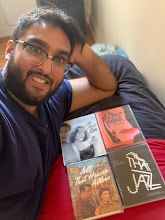Alfred Hitchcock is one of my favorite directors--probably my most favorite. With a career spanning over 50 years, he made 53 films and I haven't even seen them all! But his career is diverse, full of major classics and obscure gems. So here's a guide to getting into the films of the Master of Suspense.
First start with Rear Window (1954)
Rear Window is probably the most accessible of Hitchcock's famous movies. It's a thriller with a good mystery plus it has some comedy, romance and social commentary thrown in. Truthfully, this is one of the best expressions of Hitchcock's command over filmmaking.
Then jump back 19 years to The 39 Steps (1935)
One of Hitchcock's favorite themes was the wrongly accused man. The 39 Steps was the first iteration of the "wrong man" theme and features of a lot of great Hitchcockian touches, and you'd be surprised how modern it feels for being 80 years old.
Skip another 11 years for Notorious (1946)
Notorious is one of the most beautifully filmed spy thrillers of all time. Hitchcock's direction is precise and romantic. The film is a psychological romance, with a nuanced push/pull relationship between Ingrid Bergman and Cary Grant. Claude Rains co-stars as a sweet, sympathetic Nazi.
Don't avoid the Strangers on a Train (1951)
What I love about this movie is its criss-cross story and how Hitchcock stages his scenes with slow-build suspense. Strangers on a Train has some great scenes and overall it's a tense movie to watch. I think that Hitchcock really did a fantastic job of showing paranoia through visuals and using his growing reputation as Master of Suspense to get in some risky material.
Now you're ready for Psycho (1960)...
The thing is, Psycho is one of Hitchcock's most famous films, if not the most. But I don't think it makes for a good intro. Because after years of knockoffs, parodies and homages, the shocking twists of Psycho aren't so shocking anymore. So, after getting a real appreciation of Hitchcock's style, you can really enjoy the impact of Psycho.
Take a trip to Hitchcock's America in Shadow of a Doubt (1942)
In the 1940s, Hitchcock moved from England to Hollywood. Most of his first Hollywood films were still British in spirit. Shadow of a Doubt was the first truly American film that he made and he found it a great place to explore the dark recesses of the mind beneath the small town optimism. The dialogue is terrifically sharp. This was Hitchcock's favorite movie and it's not hard to see why.
Check out The Lady Vanishes (1939)
Of Hitchcock 1930s films, The Lady Vanishes is perhaps the most entertaining. It has such a unique structure. The first portion of the movie is comedy, with some mysterious bits. Then the film shifts to a more suspense vibe. Much like The 39 Steps and Rear Window, Hitchcock is able to find comedy even in a tense thriller.
Next, North by Northwest (1959)
North by Northwest is quintessential Hitchcock. It is the perfect marriage of his favorite theme--the wrong man--and his sense of dry humor. And it is the kind of movie that has such visceral thrills--the crop dusting scene alone is a major heart pumper. As you go through this film, it's so fun to catch all the Hitchcockian elements. You could really pick out a scene and break it down and have a good time of it.
Then head over to Best Picture winner Rebecca (1940)
Rebecca is a gothic Romance that's filmed like a horror film. Hitchcock was forced to remain faithful to Daphne Du Maurier's source novel. But he did give the film a Hitchcock touch, with expressionistic lighting, oversized doors and psychological torment. Rebecca doesn't become a real suspense story until the last 20 minutes or so--also the weakest part of the movie--but the film feels suspenseful on an emotional level.
And finally the masterpiece, Vertigo (1958)
Vertigo is my favorite movie of all time. And I think it is best experienced three times before you make a judgment. Once for the plot. Twice for the atmosphere and music. And the third time to appreciate how cyclical the movie is. The film is a mirror of itself and it's loopy structure is very rewarding. I can't even remember how many times I've seen this movie but honestly, it feels new each time. That's such a cliche. But for me this movie will never get stale.
Where to go from here?
The Birds
To Catch a Thief
Spellbound
Frenzy
The Man Who Knew Too Much (both the 1934 and 1956 versions)
Like what you read? Please like my blog at Facebook.com/MathurMarquee. Also, follow me on Twitter @HippogriffRider. Agree? Disagree? Sound off in the comments below!
Subscribe to:
Post Comments (Atom)













No comments:
Post a Comment